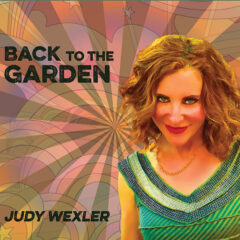CD Reviews
JUDY WEXLER: Back to the Garden
By 1950, big bands were no longer enjoying their heyday. The generation who had filled the dance floors to Glen Miller and the Dorsey brothers was older, married, and raising families of baby boomers. Though big bands continued to perform for decades afterwards, in many ways they became musical relics of the 1940s.
The big bands had been eclipsed by bebop, jazz that excited its listeners with breakneck tempos and explorations into new fields of jazz harmony. And yet, by 1958 bebop no longer had the verve it once had during the post-war period. Its patron saint, Charlie Parker, had passed away three years before, and listeners were advancing on to the birth of the cool.
Bebop, big band, bluegrass, classical music, each genre has its halcyon period, a time of great creativity when a Beethoven rewrites the rules for what classical concert goers can expect, a time when an Earl Scruggs lets everyone know that there is a new way to play the banjo and inaugurates bluegrass music, a time when a Django Reinhardt imbues swing and jazz with a Gypsy flair.
The 1960s and 1970s was such a time for pop music. Besides the explosion in sonic creativity—tapping into more complex harmonic and melodic structure, adding the influence of the Asian subcontinent, using new studio techniques and manipulations, and amplifiers the size of Mack trucks with feedback, feedback, feedback!!!!—lyrics changed as well. Subject matter went beyond romance and the cost of that doggie in window to social issues, protest, and personal experiences that had been outside the lyrical content of pop songs beforehand.
For her recent CD, Back to the Garden, Judy Wexler chooses ten songs of the era whose lyrics express the zeitgeist of the time. She chose gems that have also aged well, like “Everybody’s Talkin’” and “For What It’s Worth.”
With arrangers Jeff Colella and Josh Nelson, Wexler smartly reworks these tunes and brings them new life. I’m a bit hesitant to call the arrangements jazz, for fear of giving the impression that they are performed big band style or that a walking bass line lies at the foundation of the music. Rather, the arrangements draw on jazz harmonies and improvisation and are performed by a well-chosen lot of musicians. The arrangements give Wexler’s voice a lot of room. She uses the space well, gliding her voice on top of the band.
Big kudos to Wexler and her crew for freeing “The Times They Are a Changin’” from its three-chord form. The song can be plodding and come off as judgmental and preachy, but here Wexler softens the approach and invites the listener to hear the lyrics. I’ve heard this song a lot. This version moved me as never before.
Wexler includes “American Tune,” one of the greatest songs from the greatest songwriter of this generation, Paul Simon. The song summed up the mid-seventies anomie and malaise that came to a generation who saw the miserable Vietnam war come home with the slaughter of students at Jackson State and Kent State, who saw two men who embodied the hope of the country, Martin Luther King and Bobby Kennedy, struck down just as senselessly, and who saw the inner ugliness of an administration exposed with Watergate.
Disappointment and distrust, best expressed by Pete Townshend and the Who with “Won’t Get Fooled Again,” had been brewing, once folks realized that it didn’t matter if the revolution was televised or not; the new boss is the same as the old boss. In “American Tune” Simon acknowledges the feelings of many as he sings of being forsaken and misused. He continues:
And I don’t know a soul who’s not been battered
I don’t have a friend who feels at ease
I don’t know a dream that’s not been shattered
or driven to its knees
The times had been changing, and things seemed to have changed into a pretty sorry state for a lot of people. It could be easy to wallow in cynicism and bitterness, but Simon rescues our desire for life. He tells the folks who lived through the promise of almost endless possibilities, a summer of love, and believing that the most thorny problems might be solved by raising an index and middle finger and flashing a peace sign that, no, you can’t be forever blessed, and the sooner you come to that realization, the sooner you might free yourself from your miseries.
All the recording engineering for Back to the Garden is top notch. This is a terrific CD: great songs, great arrangements, and great singing. So get the Nehru jacket out of the attic, dust off the lava lamps and black lights, and enjoy a new take on some of your grandma’s music.






